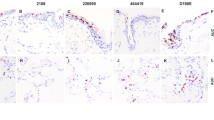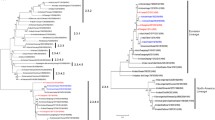Abstract
Poor human-to-human transmission of influenza A H5N1 virus has been attributed to the paucity of putative sialic acid α2-3 virus receptors in the epithelium of the human upper respiratory tract, and thus to the presumed inability of the virus to replicate efficiently at this site. We now demonstrate that ex vivo cultures of human nasopharyngeal, adenoid and tonsillar tissues can be infected with H5N1 viruses in spite of an apparent lack of these receptors.


Similar content being viewed by others
References
Shinya, K. et al. Nature 440, 435–436 (2006).
van Riel, D. et al. Science 312, 399 (2006).
Matrosovich, M.N. et al. Proc. Natl. Acad. Sci. USA 101, 4620–4624 (2004).
Chan, M.C. et al. Respir. Res. 6, 135–148 (2005).
Cheung, C.Y. et al. Lancet 360, 1831–1837 (2002).
Helander, A. et al. J. Virol. 77, 7964–7977 (2003).
Imberty, A. et al. J. Biol. Chem. 275, 17541–17548 (2000).
Konami, Y., Yamamoto, K., Osawa, T. & Irimura, T. FEBS Lett. 342, 334–338 (1994).
Gambaryan, A.S. et al. Virology 326, 310–316 (2004).
Gambaryan, A. et al. Virology 334, 276–283 (2005).
Stevens, J. et al. Science 312, 404–410 (2006).
Acknowledgements
We thank K. Fung, C.Y. Sing and I.H.Y. Ng for their technical expertise. This work was supported by the Wellcome Trust UK, by Research Fund for Control of Infectious Disease grants 03040872 and 06060552 from the Health, Welfare and Food Bureau, Government of the Hong Kong Special Administrative Region, People's Republic of China, and by Research Grants Council Central Allocation HKU 1/05C from the Government of the Hong Kong Special Administrative Region, People's Republic of China.
Author information
Authors and Affiliations
Contributions
J.M.N. and J.S.M.P. designed and coordinated the experiments. M.C.W.C., W.Y.C., H.K.W., C.Y.C., L.L.M.P. and Y.G. performed the infection with influenza viruses and interpreted the results. D.L.W.K. provided the upper respiratory tract biopsies, and W.H.C. provided the lung tissues. M.P.W. interpreted the results of the lung biopsies, and S.W.T. provided the human primary nasopharyngeal epithelial cells.
Corresponding authors
Ethics declarations
Competing interests
The authors declare no competing financial interests.
Supplementary information
Supplementary Fig. 1
Sections of lung tissue cultured for 20 h with (a,b) A/Vietnam/3046/04 (H5N1) and (c,d) A/HK/54/98 (H1N1). (PDF 131 kb)
Supplementary Fig. 2
Distribution of Maackia amurensis (MAA) in the human respiratory tract using biotinylated lectins MAA1 and 2. (PDF 195 kb)
Rights and permissions
About this article
Cite this article
Nicholls, J., Chan, M., Chan, W. et al. Tropism of avian influenza A (H5N1) in the upper and lower respiratory tract. Nat Med 13, 147–149 (2007). https://doi.org/10.1038/nm1529
Received:
Accepted:
Published:
Issue Date:
DOI: https://doi.org/10.1038/nm1529
- Springer Nature America, Inc.
This article is cited by
-
Cell-penetrating peptide-mediated cell entry of H5N1 highly pathogenic avian influenza virus
Scientific Reports (2020)
-
Whole transcriptome analysis reveals differential gene expression profile reflecting macrophage polarization in response to influenza A H5N1 virus infection
BMC Medical Genomics (2018)
-
Replication of H9 influenza viruses in the human ex vivo respiratory tract, and the influence of neuraminidase on virus release
Scientific Reports (2017)
-
Human lung ex vivo infection models
Cell and Tissue Research (2017)
-
Reassessing the role of the NLRP3 inflammasome during pathogenic influenza A virus infection via temporal inhibition
Scientific Reports (2016)





